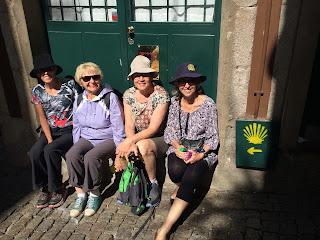We had been expecting the weather to be a lot warmer in Portugal, however it appears that the cold front has moved in and it was definitely NOT shorts weather!
We began the day walking down to the old station - Sao Bento - to organise our tickets to Tui. Our AirBnB is in an area close to the old quarter and the walk down the hill took us past many old churches and buildings.
We began the day walking down to the old station - Sao Bento - to organise our tickets to Tui. Our AirBnB is in an area close to the old quarter and the walk down the hill took us past many old churches and buildings.
Of course the retail opportunities beckoned and it took us quite some time to find the station. It has a spectacular interior and was very busy with both tourists and regular metro travellers.
It took some time for us to work out where the information window was - behind a glass door, with people having to queue outside as only one at a time was allowed in. The attendant had only halting english but he provided us with a timetable that we could understand! Next we had to take a ticket in order to queue to purchase our tickets to Valença. There are only 2 trains to Tui each day and it is fairly easy to catch a cab across the bridge into Tui.
Having purchased our tickets, we headed for a coffee shop before exploring further. Our first stop was the cathedral, where a number of the Portuguese Camino walkers start. We found the way mark for the walk and followed the way the pilgrims would take out of the city.
Eventually we deviated from the pilgrim's path and headed for the gardens that housed the Crystal Palace. Built in the 19th century, the palace was demolished in 1956 and replaced by the Pavilhao Rosa Mota. This pavilion now hosts Porto's major sporting and entertainment events. The gardens remain as they were originally planned by Emille David to complement the Palace. We enjoyed wandering the paths and particularly the views out to the Duoro River.
We charted a route back to our accommodation through the art area and the night spot, enjoying the displays of art and unexpected shops that popped up between the derelict and deserted buildings. One was selling clothes made from recycled fabrics - we liked the hats made from old jeans - and another was selling homemade jams and preserves.
It is clear that Porto was a city of great opulence at one stage - the buildings are very grand and the exterior tiles are beautiful. Unfortunately everything is very run down and many of the buildings are now covered in graffiti.





















































